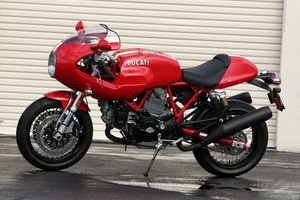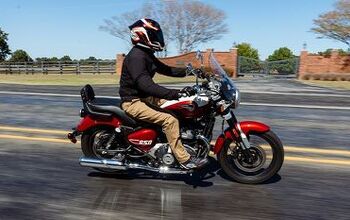Ducati Sport 1000S - Motorcycle.com
If Honda and Ducati received attention from the motorcycle press proportionate to the number of motorcycles they actually sell, you would see 35 Honda or Harley-Davidson reviews for every story about a Bologna V-Twin. Instead, it's Ducati this, Ducati that, Ducati, Ducati, Ducati.
If the purpose of motorcycle publications was solely to "assist the readership in making an informed decision" about what to buy -- as Motorcycle.com subscriber Nesbit says -- there would be no point at all in writing about Ducatis; they represent less than one percent of all motorcycles sold in the United States. You almost have a better chance of being struck by lighting than of purchasing one of maybe 1,000 1098 Superbikes that will be sold in the USA. That's about .6 percent of all sportbikes sold here.
And how can you not want to read about one of the most beautiful motorcycles Ducati has made in recent times?
For 2006, Ducati buyers world-wide were allowed to buy these three bikes. The production versions were remarkably similar to the show bikes, and they sold very well indeed: according to European Correspondent Yossef Schvetz's test of the GT1000 last year, something like 30 percent of Ducati's sales worldwide are of the Sport Classics line. For 2007 the bikes return with just a few changes.
For those of you who don't obsessively read every word written about Ducatis, here's some quick low-down on the Sport 1000S. The heart of this bike is that DS1000 motor, which first appeared in 2003, a descendent of the first Pantah belt-driven cam motors that replaced Ducati's first generation bevel-drive cam motors. It works its magic by dint of almost every part from the old 900 motor getting a redesign, as well as being bigger and receiving an extra sparkplug. For 2007, other models in the Ducati line get an 1100cc version of this engine, but for some reason the Monster and Sport Classics only get the 1000. Maybe there's a whole warehouse full of the 1000cc pistons. Who knows? What we do know is this motor makes 81.07hp on our Dynojetto di Motociclo.com, with 61.67 foot-pounds of torque, and can rev to almost 9,000 rpm.
Ducati has been trying to get service costs under control for many of their models for some time now, and 2007 marks a major milestone in their cost-cutting campaign. The service schedule is now greatly simplified; the owner need only visit his shop for ritual demoney-fying every 7,500 miles after the initial 600-mile service.
Gasp! This means that your Grandpa's advice to change engine oil every 2,000 miles is being ignored. Instead, Ducati recommends using full-synthetic Shell Advance Ultra 4, and it makes sense; synthetic oil's main advantage over rock oil is that it resists breakdown for a much longer time, so why not double the oil-change intervals? And fuel injection can adjust itself enough so that it doesn't require attention as frequently, so why not just check your chain and tire pressures yourself and ride, ride, ride?
But if you want to just have The Man do your service for you, relax. According to Ducati's suggested service pricing, all the services to (but not including the 30k service) the 30,000-mile mark should run a mere $1,833, not including sales tax on parts, figuring a $75 per hour labor rate. This includes three valve adjustments and a cam belt replacement, but not tires, brake pads, or chains. Not bad; most bikes (even Japanese ones) usually cost over $2,000 in that same period to maintain at a dealer.
More by Gabe Ets-Hokin, Senior Editor

































Comments
Join the conversation